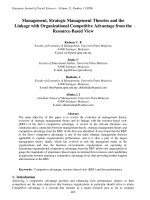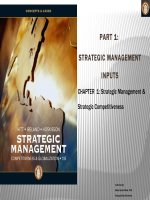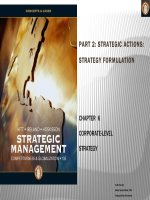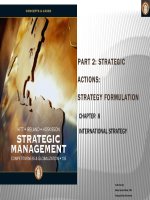Concept Strategic management Competitiveness and Globalization 9e hitt ireland hoskisson
Bạn đang xem bản rút gọn của tài liệu. Xem và tải ngay bản đầy đủ của tài liệu tại đây (14.18 MB, 449 trang )
T • I RE
ISSON
HIT
ND • HO
SK
LA
Concepts
Strategic Management
Competitiveness & Globalization
9th Edition
Michael A. Hitt
Texas A&M University
R. Duane Ireland
Texas A&M University
Robert E. Hoskisson
Rice University
Strategic Management: Competitiveness
and Globalization: Concepts, Ninth Edition
Michael A. Hitt, Duane Ireland, and
Robert E. Hoskisson
VP/Editorial Director:
Jack W. Calhoun
Editor-in-Chief:
Melissa Acuna
© 2011, 2009 South-Western, a Part of Cengage Learning
ALL RIGHTS RESERVED. No part of this work covered by the copyright
herein may be reproduced, transmitted, stored or used in any form
or by any means graphic, electronic, or mechanical, including but not
limited to photocopying, recording, scanning, digitizing, taping, Web
distribution, information networks, or information storage and retrieval
systems, except as permitted under Section 107 or 108 of the 1976
United States Copyright Act, without the prior written permission of the
publisher.
Senior Acquisitions Editor:
Michele Rhoades
Director of Development:
John Abner
For product information and technology assistance, contact us at
Cengage Learning Customer & Sales Support, 1-800-354-9706
Senior Editorial Assistant:
Ruth Belanger
For permission to use material from this text or product,
submit all requests online at www.cengage.com/permissions
Further permissions questions can be emailed to
Marketing Manager:
Nathan Anderson
Senior Marketing Communications Manager:
Jim Overly
Marketing Coordinator:
Suellen Ruttkay
Content Project Manager:
Jacquelyn K Featherly
Media Editor:
Rob Ellington
Senior Manufacturing Coordinator:
Sandee Milewski
Production House/Compositor:
Cadmus Communications
Senior Art Director:
Tippy McIntosh
Cover and Internal Designer:
Craig Ramsdell, Ramsdell Design
Cover Image:
©Media Bakery
ExamView® and ExamView Pro® are registered trademarks of
FSCreations, Inc. Windows is a registered trademark of the Microsoft
Corporation used herein under license. Macintosh and Power Macintosh
are registered trademarks of Apple Computer, Inc. used herein under
license.
Concepts ISBN 13: 978-0-538-75309-8
Concepts ISBN 10: 0-538-75309-9
South-Western Cengage Learning
5191 Natorp Boulevard
Mason, OH 45040
USA
Cengage Learning products are represented in Canada
by Nelson Education, Ltd.
For your course and learning solutions, visit www.cengage.com
Purchase any of our products at your local college store or at our
preferred online store www.ichapters.com
Printed in Canada
1 2 3 4 5 6 7 13 12 11 10 09
Qwerty on KAT for More
To Ashlyn and Aubrey
Your smiles are like sunshine—they brighten my day.
—Michael A. Hitt
To my entire family
I love each of you dearly and remain so grateful for your incredibly strong support
and encouragement over the years. Your words and deeds have indeed showed
me how to “keep my good eye to the sun and my blind eye to the dark.”
—R. Duane Ireland
To my wonderful grandchildren (Mara, Seth, Roselyn, Ian, Abby, Madeline,
Joseph, and Nadine), who are absolutely amazing and light up my life.
—Robert E. Hoskisson
iii
Brief Contents
Preface
xiv
Part 1: Strategic Management Inputs
1
1. Strategic Management and Strategic Competitiveness, 2
2. The External Environment: Opportunities, Threats, Industry
Competition, and Competitor Analysis, 34
3. The Internal Organization: Resources, Capabilities, Core
Competencies, and Competitive Advantages, 70
Part 2: Strategic Actions: Strategy Formulation
97
4. Business-Level Strategy, 98
5. Competitive Rivalry and Competitive Dynamics, 128
6. Corporate-Level Strategy, 156
7. Merger and Acquisition Strategies, 186
8. International Strategy, 216
9. Cooperative Strategy, 252
Part 3: Strategic Actions: Strategy Implementation
283
10. Corporate Governance, 284
11. Organizational Structure and Controls, 316
12. Strategic Leadership, 350
13. Strategic Entrepreneurship, 378
Part 4: Cases
Name Index, I-1
Company Index, I-15
Subject Index, I-18
iv
1
Brief Contents
Preface xiv
About the Authors
xxi
Part 1: Strategic Management Inputs
1
1: Strategic Management and Strategic
Competitiveness 2
Opening Case: McDonald’s Corporation: Firing on All
Cylinders while Preparing for the Future 3
Strategic Focus: Circuit City: A Tale of Ineffective Strategy
Implementation and Firm Failure 7
The Competitive Landscape
The Global Economy
8
9
Technology and Technological Changes
The I/O Model of Above-Average Returns
11
13
The Resource-Based Model of Above-Average Returns
Vision and Mission
Vision
Mission
15
16
17
18
Strategic Focus: Effective Vision and Mission Statements: Why Firms Need Them
Stakeholders
19
20
Classifications of Stakeholders
Strategic Leaders
20
23
The Work of Effective Strategic Leaders
23
Predicting Outcomes of Strategic Decisions: Profit Pools 24
The Strategic Management Process
25
Summary 26 • Review Questions 27 • Experiential Exercises 27
Video Case 28 • Notes 29
2: The External Environment: Opportunities, Threats, Industry
Competition, and Competitor Analysis 34
Opening Case: Philip Morris International: The Effects of Its External
Environment 35
The General, Industry, and Competitor Environments
External Environmental Analysis
37
39
v
vi
Contents
Scanning
40
Monitoring
Forecasting
Assessing
40
41
41
Strategic Focus: Consumers’ Desire to Receive Additional Value
When Purchasing Brand-Name Products 42
Segments of the General Environment
The Demographic Segment
The Economic Segment
43
45
The Political/Legal Segment
The Sociocultural Segment
The Technological Segment
The Global Segment
43
46
46
47
48
The Physical Environment Segment
Industry Environment Analysis
49
50
Strategic Focus: Firms’ Efforts to Take Care of the Physical Environment In Which
They Compete 51
Threat of New Entrants
52
Bargaining Power of Suppliers
Bargaining Power of Buyers
55
56
Threat of Substitute Products
56
Intensity of Rivalry Among Competitors
Interpreting Industry Analyses
Strategic Groups
57
58
59
Competitor Analysis
59
Ethical Considerations
61
Summary 62 • Review Questions 62 • Experiential Exercises 63
Video Case 64 • Notes 65
3: The Internal Organization: Resources,
Capabilities, Core Competencies, and
Competitive Advantages 70
Opening Case: Apple Defies Gravity with Innovative
Genius 71
Analyzing the Internal Organization
The Context of Internal Analysis
Creating Value
73
73
74
The Challenge of Analyzing the Internal Organization
75
Strategic Focus: GE Builds Management Capabilities and Shares
Them with Others 77
Resources, Capabilities, and Core Competencies
Resources
Capabilities
78
78
80
Core Competencies
80
Building Core Competencies
82
Four Criteria of Sustainable Competitive Advantage
82
Strategic Focus: Ryanair: The Passionate Cost Cutter That Is Both Loved and Hated 84
Value Chain Analysis
Outsourcing
89
85
vii
90
Contents
Competencies, Strengths, Weaknesses, and Strategic Decisions
Summary 91 • Review Questions 91 • Experiential Exercises 92
Video Case 93 • Notes 93
Part 2: Strategic Actions: Strategy Formulation
97
4: Business-Level Strategy 98
Opening Case: Acer Group: Using a “Bare Bones” Cost
Structure to Succeed in Global PC Markets 99
Customers: Their Relationship with Business-Level
Strategies 101
Effectively Managing Relationships with Customers
101
Reach, Richness, and Affiliation 102
Who: Determining the Customers to Serve 103
What: Determining Which Customer Needs to Satisfy
104
How: Determining Core Competencies Necessary to Satisfy
Customer Needs 104
The Purpose of a Business-Level Strategy 105
Types of Business-Level Strategies
Cost Leadership Strategy
Differentiation Strategy
Focus Strategies
107
108
112
116
Strategic Focus: Declaring War against Counterfeiters to Protect Product Integrity
and Profitability 117
Strategic Focus: Kazoo Toys: Crisp Differentiation as a Means of Creating Value for a
Certain Set of Customers 119
Integrated Cost Leadership/Differentiation Strategy
120
Summary 123 • Review Questions 124 • Experiential Exercises 124
Video Case 125 • Notes 125
5: Competitive Rivalry and Competitive Dynamics 128
Opening Case: Competition in Recessions: Let the Bad Times Roll
A Model of Competitive Rivalry
Competitor Analysis
129
132
133
Market Commonality
Resource Similarity
133
134
Drivers of Competitive Actions and Responses
135
Strategic Focus: The Competitive Battle among Big Box Retailers: Wal-Mart
versus All the Others 137
Competitive Rivalry
138
Strategic and Tactical Actions
Likelihood of Attack
First-Mover Incentives
Organizational Size
Quality
138
139
139
140
141
Likelihood of Response
142
Type of Competitive Action
Actor’s Reputation
Dependence on the Market
Competitive Dynamics
Slow-Cycle Markets
142
143
144
144
143
Contents
viii
Fast-Cycle Markets
145
Strategic Focus: Soothing the Soul with Kisses—Candy Kisses That Is
Standard-Cycle Markets
147
148
Summary 149 • Review Questions 150 • Experiential Exercises 150
Video Case 151 • Notes 151
6: Corporate-Level Strategy 156
Opening Case: Foster’s Group Diversification into the
Wine Business 157
Levels of Diversification 159
Low Levels of Diversification 159
Moderate and High Levels of Diversification 160
Reasons for Diversification 161
Value-Creating Diversification: Related Constrained and
Related Linked Diversification 163
Operational Relatedness: Sharing Activities
163
Corporate Relatedness: Transferring of Core Competencies
164
Strategic Focus: Oracle’s Related Constrained Diversification
Strategy 165
Market Power
166
Simultaneous Operational Relatedness and Corporate Relatedness
167
Unrelated Diversification 168
Efficient Internal Capital Market Allocation
168
Strategic Focus: Johnson & Johnson Uses Both Operational and Corporate
Relatedness 169
Restructuring of Assets
171
Strategic Focus: Danaher and ITW: Serial Acquirers of Diversified Industrial Manufacturing
Businesses 172
Value-Neutral Diversification: Incentives and Resources 173
Incentives to Diversify
173
Resources and Diversification 176
Value-Reducing Diversification: Managerial Motives to Diversify 177
Summary 179 • Review Questions 179 • Experiential Exercises 180
Video Case 181 • Notes 181
7: Merger and Acquisition Strategies 186
Opening Case: Global Merger and Acquisition Activity
during a Global Crisis 187
The Popularity of Merger and Acquisition Strategies
188
Mergers, Acquisitions, and Takeovers: What Are the
Differences? 189
Reasons for Acquisitions
Increased Market Power
190
190
Overcoming Entry Barriers
192
Cost of New Product Development and Increased Speed to Market
193
Strategic Focus: The Increasing Use of Acquisition Strategies by Chinese Firms as a Means
of Gaining Market Power in a Particular Industry 194
Lower Risk Compared to Developing New Products
195
Increased Diversification 195
Strategic Focus: Pfizer’s Proposed Acquisition of Wyeth: Will This Acquisition Be
Successful? 196
ix
Learning and Developing New Capabilities
Problems in Achieving Acquisition Success
197
198
Integration Difficulties 198
Inadequate Evaluation of Target
200
Large or Extraordinary Debt
200
Inability to Achieve Synergy
201
Too Much Diversification 201
Managers Overly Focused on Acquisitions
Too Large
Effective Acquisitions
Restructuring
202
203
203
205
Downsizing
205
Downscoping
206
Leveraged Buyouts
207
Restructuring Outcomes
207
Summary 208 • Review Questions 209 • Experiential Exercises 209
Video Case 210 • Notes 210
8: International Strategy 216
Opening Case: Entry Into China by Foreign Firms and
Chinese Firms Reaching for Global Markets 217
Identifying International Opportunities: Incentives to Use an
International Strategy 219
Increased Market Size
221
Return on Investment
221
Economies of Scale and Learning 222
Location Advantages
International Strategies
222
223
International Business-Level Strategy
223
International Corporate-Level Strategy
225
Strategic Focus: Country Conditions Spawn Successful High Tech Firms in Emerging
Markets 226
Environmental Trends
230
Liability of Foreignness
Regionalization
230
230
Choice of International Entry Mode
Exporting
232
Licensing
232
Strategic Alliances
Acquisitions
231
233
234
New Wholly Owned Subsidiary
Dynamics of Mode of Entry
235
236
Strategic Competitive Outcomes
237
International Diversification and Returns
237
International Diversification and Innovation
Complexity of Managing Multinational Firms
Risks in an International Environment
Political Risks
Economic Risks
238
240
238
237
238
Contents
Reshaping the Firm’s Competitive Scope 197
Contents
x
Limits to International Expansion: Management Problems
240
Strategic Focus: The Continuing Threat to Legitimate Companies from Counterfeit or Fake
Products 241
Summary 242 • Review Questions 243 • Experiential Exercises 243
Video Case 244 • Notes 245
9: Cooperative Strategy 252
Opening Case: Using Cooperative Strategies at IBM
253
Strategic Alliances as a Primary Type of Cooperative
Strategy 255
Three Types of Strategic Alliances
256
Reasons Firms Develop Strategic Alliances
Business-Level Cooperative Strategy
Complementary Strategic Alliances
257
260
260
Strategic Focus: How Complementary Alliances Are Affected by
the Global Economic Downturn 262
Competition Response Strategy
Uncertainty-Reducing Strategy
Competition-Reducing Strategy
264
Assessment of Business-Level Cooperative Strategies
Corporate-Level Cooperative Strategy
Diversifying Strategic Alliance
265
266
266
Synergistic Strategic Alliance
Franchising
263
264
267
267
Assessment of Corporate-Level Cooperative Strategies
International Cooperative Strategy
Network Cooperative Strategy
Alliance Network Types
268
268
270
270
Competitive Risks with Cooperative Strategies
Managing Cooperative Strategies
271
272
Strategic Focus: Troubles in the Russian Oil Joint Venture, TNK-BP
273
Summary 275 • Review Questions 276 • Experiential Exercises 276
Video Case 276 • Notes 277
Part 3: Strategic Actions: Strategy
Implementation 283
10: Corporate Governance 284
Opening Case: Is CEO Pay Outrageous, Irresponsibile,
or Greedy? 285
Separation of Ownership and Managerial Control
Agency Relationships
287
288
Product Diversification as an Example of an Agency Problem 289
Agency Costs and Governance Mechanisms
Ownership Concentration
292
The Growing Influence of Institutional Owners
Board of Directors
291
292
293
Enhancing the Effectiveness of the Board of Directors
295
Strategic Focus: Where Have All the Good Directors Gone?
Executive Compensation
297
The Effectiveness of Executive Compensation
298
296
xi
299
Managerial Defense Tactics
Contents
Market for Corporate Control
300
International Corporate Governance
302
Corporate Governance in Germany and Japan
Corporate Governance in China
Global Corporate Governance
302
303
304
Strategic Focus: The Satyam Truth: CEO Fraud and Corporate Governance Failure
Governance Mechanisms and Ethical Behavior
306
Summary 307 • Review Questions 308 • Experiential Exercises 308
Video Case 309 • Notes 310
11: Organizational Structure and Controls 316
Opening Case: Cisco’s Evolution of Strategy and Structure
317
Organizational Structure and Controls 318
Organizational Structure
319
Organizational Controls
320
Relationships between Strategy and Structure
321
Evolutionary Patterns of Strategy and Organizational Structure
Simple Structure
322
323
Functional Structure
323
Multidivisional Structure
323
Matches between Business-Level Strategies and the Functional Structure
324
Matches between Corporate-Level Strategies and the Multidivisional
Structure 327
Strategic Focus: Hewlett-Packard Implements the Related Constrained Strategy
through the Cooperative M-form Structure 329
Matches between International Strategies and Worldwide Structure
Matches between Cooperative Strategies and Network Structures
334
338
Strategic Focus: PepsiCo: Moving from the Geographic Area Structure toward
the Combined Structure Implementing the Transnational Strategy 339
Implementing Business-Level Cooperative Strategies
341
Implementing Corporate-Level Cooperative Strategies
Implementing International Cooperative Strategies
342
342
Summary 343 • Review Questions 344 • Experiential Exercises 344
Video Case 345 • Notes 345
12: Strategic Leadership 350
Opening Case: Selecting a New CEO: The
Importance of Strategic Leaders 351
Strategic Leadership and Style
352
The Role of Top-Level Managers
Top Management Teams
Managerial Succession
354
355
358
Strategic Focus: The Model Succession at
Xerox 360
Key Strategic Leadership Actions
361
Determining Strategic Direction
361
Effectively Managing the Firm’s Resource
Portfolio 362
Sustaining an Effective Organizational Culture
Emphasizing Ethical Practices
366
365
305
Contents
xii
Establishing Balanced Organizational Controls
367
Strategic Focus: The “Global Duke of Retail”: The New Strategic Leader of Wal-Mart
370
Summary 371 • Review Questions 372 • Experiential Exercises 372
Video Case 372 • Notes 373
13: Strategic Entrepreneurship 378
Opening Case: The Continuing Innovation Revolution at
Amazon: The Kindle and E-Books 379
Entrepreneurship and Entrepreneurial Opportunities
Innovation
381
381
Entrepreneurs
382
International Entrepreneurship
Internal Innovation
383
384
Incremental and Radical Innovation
384
Strategic Focus: Competitiveness and Innovation: Are We
Experiencing a Paradigm Shift? 385
Autonomous Strategic Behavior
Induced Strategic Behavior
386
387
Implementing Internal Innovations
388
Cross-Functional Product Development Teams
Facilitating Integration and Innovation
388
389
Creating Value from Internal Innovation
Innovation through Cooperative Strategies
390
390
Strategic Focus: All in a Twitter about My Space in Order to Be Linked in to the Book of
Faces: The Social Networking Phenomenon 392
Innovation through Acquisitions 393
Creating Value through Strategic Entrepreneurship
393
Summary 395 • Review Questions 396 • Experiential Exercises 396
Video Case 397 • Notes 397
Name Index
I1-I14
Company Index
Subject Index
I15-I17
I18-I23
Brief Contents
Preface
Our goal in writing each edition of this book is to present a new, up-to-date standard for
explaining the strategic management process. To reach this goal with the 9th edition of
our market-leading text, we again present you with an intellectually rich yet thoroughly
practical analysis of strategic management.
With each new edition, we are challenged and invigorated by the goal of establishing
a new standard for presenting strategic management knowledge in a readable style. To
prepare for each new edition, we carefully study the most recent academic research to
ensure that the strategic management content we present to you is highly current and
relevant for use in organizations. In addition, we continuously read articles appearing in
many different business publications (e.g., Wall Street Journal, BusinessWeek, Fortune,
Financial Times, and Forbes, to name a few); we do this to identify valuable examples of
how companies are actually using the strategic management process. Though many of
the hundreds of companies we discuss in the book will be quite familiar to you, some
companies will likely be new to you as well. One reason for this is that we use examples of
companies from around the world to demonstrate how globalized business has become.
To maximize your opportunities to learn as you read and think about how actual companies use strategic management tools, techniques, and concepts (based on the most
current research), we emphasize a lively and user-friendly writing style.
Several characteristics of this 9th edition of our book will enhance your learning
opportunities:
■ This book presents you with the most comprehensive and thorough coverage of strategic management that is available in the market.
■ The research used in this book is drawn from the “classics” as well as the most recent
contributions to the strategic management literature. The historically significant
“classic” research provides the foundation for much of what is known about strategic
management; the most recent contributions reveal insights about how to effectively
use strategic management in the complex, global business environment in which most
firms operate while trying to outperform their competitors. Our book also presents
you with many up-to-date or recent examples of how firms use the strategic management tools, techniques, and concepts developed by leading researchers. Indeed, this
book is strongly application oriented and presents you, our readers, with a vast number of examples and applications of strategic management concepts, techniques, and
tools. In this edition, for example, we examine more than 600 companies to describe
the use of strategic management. Collectively, no other strategic management book
presents you with the combination of useful and insightful research and applications
in a wide variety of organizations as does this text. Company examples range from the
large U.S.-based firms such as Amazon.com, Wal-Mart, IBM, Johnson & Johnson,
xiii
Preface
xiv
Hershey, Hewlett Packard, Dell, PepsiCo, and Cisco to major foreign-based firms
such as Toyota, Nokia, British Petroleum, Ryanair, Volkswagon, and Huawei. We
also include examples of successful younger and newer firms such as Dylan’s Candy
Bar, Facebook, Honest Tea, MySpace, Yandex and Sun Tech Power and middle-sized
family-owned firms such as Sargento Foods.
■ We carefully integrate two of the most popular and well-known theoretical concepts in the strategic management field: industrial-organization economics and the
resource-based view of the firm. Other texts usually emphasize one of these two
theories (at the cost of explaining the other one to describe strategic management).
However, such an approach is incomplete; research and practical experience indicate
that both theories play a major role in understanding the linkage between strategic
management and organizational success. No other book integrates these two theoretical perspectives effectively to explain the strategic management process and its
application in all types of organizations.
■ We use the ideas of prominent scholars (e.g., Raphael [Raffi] Amit, Kathy Eisenhardt,
Don Hambrick, Constance [Connie] Helfat, Ming-Jer Chen, Michael Porter,
C. K. Prahalad, Richard Rumelt, Ken Smith, David Teece, Michael Tushman, Oliver
Williamson, and many younger, emerging scholars such as Rajshree Agarwal, Gautam
Ahuja, Javier Gimeno, Amy Hillman, Michael Lennox, Yadong Luo, Jeff Reuer, Mary
Tripsas, and Maurizio Zollo [along with numerous others] to shape the discussion of
what strategic management is. We describe the practices of prominent executives and
practitioners (e.g., Mike Duke, Jeffrey Immelt, Steven Jobs, Gianfranco Lanci, Indra
Nooyi, and many others) to help us describe how strategic management is used in
many types of organizations.
■ We, the authors of this book, are also active scholars. We conduct research on different strategic management topics. Our interest in doing so is to contribute to the
strategic management literature and to better understand how to effectively apply
strategic management tools, techniques, and concepts to increase organizational performance. Thus, our own research is integrated in the appropriate chapters along
with the research of numerous other scholars, some of which are noted above.
In addition to our book’s characteristics, there are some specific features of this 9th
edition that we want to highlight for you:
■ New Opening Cases and Strategic Focus Segments. We continue our tradition of
providing all-new Opening Cases and Strategic Focus segments. In addition, new
company-specific examples are included in each chapter. Through all of these venues,
we present you with a wealth of examples of how actual organizations, most of which
compete internationally as well as in their home markets, use the strategic management process to outperform rivals and increase their performance.
■ 30 All-New Cases with an effective mix of organizations headquartered or based in
the United States and a number of other countries. Many of the cases have full financial data (the analyses of which are in the Case Notes that are available to instructors).
These timely cases present active learners with opportunities to apply the strategic
management process and understand organizational conditions and contexts and to
make appropriate recommendations to deal with critical concerns.
■ All New Video Case Exercises are now included in the end-of-chapter material for
each chapter and are directly connected to the textbook’s Fifty Lessons video collection. These engaging exercises demonstrate for students how the concepts they are
learning actually connect to the ideas and actions of the interesting individuals and
companies highlighted in the videos.
■ New and Revised Experiential Exercises to support individuals’ efforts to understand the use of the strategic management process. These exercises place active
learners in a variety of situations requiring application of some part of the strategic
management process.
xv
To maintain current and up-to-date content, new concepts are explored in the 9th edition.
In Chapter 2, we added the physical environment as the seventh segment of the general environment. The discussion of the physical environment emphasizes the importance of sustainability. Sustainability has become a “watchword” at many companies
such as Honest Tea and Dell. For example, Dell has a goal of having a carbon neutral
footprint. This discussion is integrated with the explanation in Chapter 4 of how firms
are developing a “green” strategy that is a core part of their competitive strategy. WalMart is investing significant capital and effort to be a “green” firm, as are other firms
such as Procter & Gamble and Target. We describe the actions a number of firms are
taking regarding the physical environment in one of the Strategic Focus segments in
Chapter 2.
In Chapter 6, we explore a new strategic trend also caused by the global economic
crisis. While many firms downscoped in the late 1980s and 1990s because of the performance problems caused by over-diversification, the economic recession has served as a
catalyst for a new trend of diversification to help firms spread their risk across several
markets (to avoid bankruptcy). In Chapter 7, we expand our discussion of cross-border
acquisitions. In fact, cross-border acquisitions remain quite popular during the global economic crisis, largely because of the number of firms in financial trouble that have undervalued assets as a result. Chinese firms have become especially active, which is discussed
in detail in Chapter 7 with special emphasis in a Strategic Focus segment. Chapter 8
Preface
■ Strategy Right Now is used in each chapter to highlight companies that are effectively using a strategic management concept examined in the chapter or to provide
additional coverage of a particular topic. In Chapter 5, for example, Wal-Mart’s
offering of financial services tailored to its customers’ needs, such as the MoneyCard,
is discussed in the context of competition among the big box retailers. In Chapter
13, the explosion of social media and networking, in particular Twitter, is examined
in detail. This feature is a valuable tool for readers to quickly identify how a firm is
effectively using a strategic management tool, technique, or concept. We follow up
with the most current research and information about these firms by using Cengage
Learning’s Business & Company Resource Center (BCRC). Links to specific current
news articles related to these companies and topics can be found on our website
(www.cengage.com/management/hit
www.cengage.com/management/hittt). Whenever you see the Strategy Right Now
icon in the text, you will know that current research is available from the BCRC links
posted to our website.
■ An Exceptional Balance between current research and up-to-date applications of it
in actual organizations. The content has not only the best research documentation
but also the largest amount of effective real-world examples to help active learners
understand the different types of strategies organizations use to achieve their vision
and mission.
■ Access to Harvard Business School (HBS) Cases. We have developed a set of assignment sheets and AACSB International assessment rubrics to accompany 10 of the
best selling HBS cases. Instructors can use these cases and the accompanying set of
teaching notes and assessment rubrics to formalize assurance of learning efforts in
the capstone Strategic Management/Business Policy course.
■ Lively, Concise Writing Style to hold readers’ attention and to increase their interest
in strategic management.
■ Continuing, Updated Coverage of vital strategic management topics such as competitive rivalry and dynamics, strategic alliances, mergers and acquisitions, international strategies, corporate governance, and ethics. Also, we continue to be the only
book in the market with a separate chapter devoted to strategic entrepreneurship.
■ Full four-color format to enhance readability by attracting and maintaining readers’
interests.
Preface
xvi
includes new content exampling emerging international firms from China (Sun Tech
Power in commercial solar power and ZTE and Huawei in network equipment) and
Russia (Yandex, a competitor to Google).
In Chapter 10, we added content related to the new actions and policies that deal with
corporate governance. For example, the U.S. Securities and Exchange Commission (SEC)
has implemented some new policies providing for closer oversight of companies’ financial dealings. The SEC has also developed new rules to allow owners with large stakes to
propose new directors. These new rules are likely to shift the balance even more in favor
of outside and independent members of companies’ boards of directors. We inserted a
new section into this chapter to explain corporate governance in China. As a major new
global economic power with several of the world’s largest firms, corporate governance
in China has become an important issue. Interestingly, many of the new corporate governance practices implemented in Chinese companies resemble governance practices in
the United States.
In Chapter 13, we explain how innovation has become highly important for firms to
compete effectively in global markets. As such, there have been major drives to increase
the innovativeness of firms in the United States and China. The importance of innovation has been heightened by the emphasis on sustainability (developing “greener” products—see Chapters 2 and 4) and by the growing demand from customers that companies
provide them with “excellent” value in the form of the goods or services they are making
and selling (see Chapter 2).
Supplements
Instructors
Instructor’s Resource DVD (0-538-75315-3) Key ancillaries (Instructor’s Resource
Manual, Instructor’s Case Notes, Test Bank, ExamViewTM, and PowerPoint®, as well as
the Fifty Lessons video collection) are provided on DVD, giving instructors the ultimate
tool for customizing lectures and presentations.
New Expanded Instructor Case Notes (0-538-75461-3) To better reflect the varying
approaches to teaching and learning via cases, the 9th edition offers a rich selection of
case note options:
Basic Case Notes – Each of the 30 cases in the 9th edition is accompanied by a succinct case note designed for ease of use while also providing the necessary background
and financial data for classroom discussion.
Presentation Case Notes – For a selection of 13 cases from the 9th edition, a full set
of PowerPoint slides has been developed for instructors to effectively use in class,
containing key illustrations and other case data.
Rich Assessment Case Notes – Introduced in the 8th edition, these expanded case
notes provide details about 13 additional cases from prior editions that are available
on the textbook website. These expanded case notes include directed assignments,
financial analysis, thorough discussion and exposition of issues in the case, and an
assessment rubric tied to AACSB International assurance of learning standards that
can be used for grading each case.
Available in Print, on the Instructor’s Resource DVD, or Product Support Website.
Instructor’s Resource Manual The Instructor’s Resource Manual, organized around
each chapter’s knowledge objectives, includes teaching ideas for each chapter and how to
reinforce essential principles with extra examples. This support product includes lecture
xvii
Certified Test Bank Thoroughly revised and enhanced, test bank questions are linked to
each chapter’s knowledge objectives and are ranked by difficulty and question type. We
provide an ample number of application questions throughout, and we have also retained
scenario-based questions as a means of adding in-depth problem-solving questions.
With this edition, we introduce the concept of certification, whereby another qualified
academic has proofread and verified the accuracy of the test bank questions and answers.
The test bank material is also available in computerized ExamViewTM format for creating custom tests in both Windows and Macintosh formats. Available on the Instructor’s
Resource DVD or Product Support Website.
ExamViewTM Computerized testing software contains all of the questions in the certified
printed test bank. This program is an easy-to-use test-creation software compatible with
Microsoft Windows. Instructors can add or edit questions, instructions, and answers,
and select questions by previewing them on the screen, selecting them randomly, or
selecting them by number. Instructors can also create and administer quizzes online,
whether over the Internet, a local area network (LAN), or a wide area network (WAN).
Available on the Instructor’s Resource DVD.
Video Case Program. A collection of 13 new videos from Fifty Lessons have been
selected for the 9th edition, and directly connected Video Case exercises have been
included in the end-of-chapter material of each chapter. These new videos are a comprehensive and compelling resource of management and leadership lessons from some
of the world’s most successful business leaders. In the form of short and powerful
videos, these videos capture leaders’ most important learning experiences. They share
their real-world business acumen and outline the guiding principles behind their most
important business decisions and their career progression. Available on the Instructor’s
Resource DVD.
PowerPoint® An all-new PowerPoint presentation, created for the 9th edition, provides
support for lectures, emphasizing key concepts, key terms, and instructive graphics.
Slides can also be used by students as an aid to note-taking. Available on the Instructor’s
Resource DVD or Product Support Website.
WebTutorTM WebTutor is used by an entire class under the direction of the instructor and is particularly convenient for distance learning courses. It provides Web-based
learning resources to students as well as powerful communication and other course management tools, including course calendar, chat, and e-mail for instructors. See http://
www.cengage.com/tlc/webtutor for more information.
Product Support Website (www.cengage.com/management/hitt) Our Product Support
Website contains all ancillary products for instructors as well as the financial analysis
exercises for both students and instructors.
The Business & Company Resource Center (BCRC) Put a complete business library at
your students’ fingertips! This premier online business research tool allows you and your
students to search thousands of periodicals, journals, references, financial data, industry
reports, and more. This powerful research tool saves time for students—whether they
are preparing for a presentation or writing a reaction paper. You can use the BCRC to
quickly and easily assign readings or research projects. Visit />bcrc to learn more about this indispensable tool. For this text in particular, BCRC will
be especially useful in further researching the companies featured in the text’s 30 cases.
We’ve also included BCRC links for the Strategy Right Now feature on our website, as
well as in the Cengage NOW product.
Preface
outlines, detailed answers to end-of-chapter review questions, instructions for using each
chapter’s experiential exercises and video cases, and additional assignments. Available on
the Instructor’s Resource DVD or Product Support Website.
Preface
xviii
Qwerty on KAT for More
Student Premium Companion Site The new optional student premium website features text-specific resources that enhance student learning by bringing concepts to life.
Dynamic interactive learning tools include online quizzes, flashcards, PowerPoint slides,
learning games, and more, helping to ensure your students come to class prepared! Ask
your Cengage Learning sales representative for more details.
Students
Financial analyses of some of the cases are provided on our Product Support
Website for both students and instructors. Researching financial data, company data,
and industry data is made easy through the use of our proprietary database, the Business
& Company Resource Center. Students are sent to this database to be able to quickly
gather data needed for financial analysis.
Make It Yours – Custom Case Selection
Cengage Learning is dedicated to making the educational experience unique for all learners by creating custom materials that best suit your course needs. With our Make It
Yours program, you can easily select a unique set of cases for your course from providers
such as Harvard Business School Publishing, Darden, and Ivey. See tom.
cengage.com/makeityours/hitt9e for more details.
Acknowledgments
We express our appreciation for the excellent support received from our editorial and
production team at South-Western. We especially wish to thank Michele Rhoades, our
Senior Acquisitions Editor; John Abner, our Development Editor; Nate Anderson, our
Marketing Manager; and Jaci Featherly, our Content Project Manager. We are grateful
for their dedication, commitment, and outstanding contributions to the development
and publication of this book and its package of support materials.
We are highly indebted to the reviewers of the 8th edition in preparation for this
current edition:
Erich Brockmann
University of New Orleans
Bruce H. Charnov
Hofstra University
Scott Elston
Iowa State University
Susan Hansen
University of Wisconsin-Platteville
Carol Jacobson
Purdue University
Frank Novakowski
Davenport University
Consuelo M. Ramirez
University of Texas at San Antonio
Manjula S. Salimath
University of North Texas
Deepak Sethi
Old Dominion University
Manisha Singal
Virginia Tech
Len J. Trevino
Washington State University
Edward Ward
Saint Cloud State University
Marta Szabo White
Georgia State University
Michael L Williams
Michigan State University
Diana J. Wong-MingJi
Eastern Michigan University
Wilson Zehr
Concordia University
xix
Charles Byles
Virginia Commonwealth University
Paul Friga
University of North Carolina
Richard H. Lester
Texas A&M University
Paul Mallette
Colorado State University
Kristi L. Marshall
Michael A. Hitt
R. Duane Ireland
Robert E. Hoskisson
Preface
Finally, we are very appreciative of the following people for the time and care that
went into preparing the supplements to accompany this edition:
About the Authors
Michael A. Hitt
Michael A. Hitt is a Distinguished Professor and holds the Joe B. Foster Chair in Business
Leadership at Texas A&M University. He received his Ph.D. from the University of
Colorado. He has more than 260 publications including 26 co-authored or co-edited
books and was cited as one of the 10 most-cited scholars in management over a 25-year
period in an article published in the 2008 volume of the Journal of Management.
Some of his books are Downscoping: How to Tame the Diversified Firm (Oxford
University Press, 1994); Mergers and Acquisitions: A Guide to Creating Value for
Stakeholders (Oxford University Press, 2001); Competing for Advantage, 2nd edition
(South-Western, 2008); and Understanding Business Strategy, 2nd edition (SouthWestern Cengage Learning, 2009). He is co-editor of several books including the following: Managing Strategically in an Interconnected World (1998); New Managerial
Mindsets: Organizational Transformation and Strategy Implementation (1998); Dynamic
Strategic Resources: Development, Diffusion, and Integration (1999); Winning Strategies in
a Deconstructing World (John Wiley & Sons, 2000); Handbook of Strategic Management
(2001); Strategic Entrepreneurship: Creating a New Integrated Mindset (2002); Creating
Value: Winners in the New Business Environment (Blackwell Publishers, 2002); Managing
Knowledge for Sustained Competitive Advantage (Jossey-Bass, 2003); Great Minds in
Management: The Process of Theory Development (Oxford University Press, 2005), and
The Global Mindset (Elsevier, 2007). He has served on the editorial review boards of multiple journals, including the Academy of Management Journal, Academy of Management
Executive, Journal of Applied Psychology, Journal of Management, Journal of World
Business, and Journal of Applied Behavioral Sciences. Furthermore, he has served as
consulting editor and editor of the Academy of Management Journal. He is currently a
co-editor of the Strategic Entrepreneurship Journal. He is the current past president of the
Strategic Management Society and is a past president of the Academy of Management.
He is a Fellow in the Academy of Management and in the Strategic Management
Society. He received an honorary doctorate from the Universidad Carlos III de Madrid
and is an Honorary Professor and Honorary Dean at Xi’an Jiao Tong University. He
has been acknowledged with several awards for his scholarly research and he received
the Irwin Outstanding Educator Award and the Distinguished Service Award from the
Academy of Management. He has received best paper awards for articles published in
the Academy of Management Journal, Academy of Management Executive, and Journal
of Management.
xx
xxi
Robert E. Hoskisson
Robert E. Hoskisson is the George R. Brown Chair of Strategic Management at the Jesse
H. Jones Graduate School of Business, Rice University. He received his Ph.D. from the
University of California-Irvine. Professor Hoskisson’s research topics focus on corporate governance, acquisitions and divestitures, corporate and international diversification, corporate entrepreneurship, privatization, and cooperative strategy. He teaches
courses in corporate and international strategic management, cooperative strategy, and
strategy consulting, among others. Professor Hoskisson’s research has appeared in over
120 publications, including articles in the Academy of Management Journal, Academy
of Management Review, Strategic Management Journal, Organization Science, Journal
of Management, Journal of International Business Studies, Journal of Management
Studies, Academy of Management Perspectives, Academy of Management Executive,
California Management Review, and 26 co-authored books. He is currently an associate editor of the Strategic Management Journal and a consulting editor for the Journal
of International Business Studies, as well as serving on the Editorial Review board of
About the Authors
R. Duane Ireland
R. Duane Ireland is a Distinguished Professor and holds the Foreman R. and Ruby
S. Bennett Chair in Business from the Mays Business School, Texas A&M University
where he previously served as head of the management department. He teaches strategic management courses at all levels (undergraduate, masters, doctoral, and executive). He has over 175 publications including more than a dozen books. His research,
which focuses on diversification, innovation, corporate entrepreneurship, and strategic entrepreneurship, has been published in a number of journals, including Academy
of Management Journal, Academy of Management Review, Academy of Management
Executive, Administrative Science Quarterly, Strategic Management Journal, Journal of
Management, Strategic Entrepreneurship Journal, Human Relations, Entrepreneurship
Theory and Practice, Strategic Entrepreneurship Journal, Journal of Business Venturing,
and Journal of Management Studies, among others. His recently published books include
Understanding Business Strategy, 2nd edition (South-Western Cengage Learning,
2009), Entrepreneurship: Successfully Launching New Ventures, 3rd edition (PrenticeHall, 2010), and Competing for Advantage, 2nd edition (South-Western, 2008). He is
serving or has served as a member of the editorial review boards for a number of journals, including Academy of Management Journal, Academy of Management Review,
Academy of Management Executive, Journal of Management, Strategic Enterprenurship
Journal, Journal of Business Venturing, Entrepreneurship Theory and Practice, Journal
of Business Strategy, and European Management Journal. He is the current editor of the
Academy of Management Journal. He has completed terms as an associate editor for
Academy of Management Journal, as an associate editor for Academy of Management
Executive, and as a consulting editor for Entrepreneurship Theory and Practice. He has
co-edited special issues of Academy of Management Review, Academy of Management
Executive, Journal of Business Venturing, Strategic Management Journal, Journal of High
Technology and Engineering Management, and Organizational Research Methods (forthcoming). He received awards for the best article published in Academy of Management
Executive (1999) and Academy of Management Journal (2000). In 2001, his co-authored
article published in Academy of Management Executive won the Best Journal Article
in Corporate Entrepreneurship Award from the U.S. Association for Small Business &
Entrepreneurship (USASBE).
He is a Fellow of the Academy of Management and is a 21st Century Entrepreneurship
Research Scholar. He served a three-year term as a Representative-at-Large member of
the Academy of Management’s Board of Governors. He received the 1999 Award for
Outstanding Intellectual Contributions to Competitiveness Research from the American
Society for Competitiveness and the USASBE Scholar in Corporate Entrepreneurship
Award (2004).
About the Authors
xxii
the Academy of Management Journal. Professor Hoskisson has served on several
editorial boards for such publications as the Academy of Management Journal (including
consulting editor and guest editor of a special issue), Journal of Management (including associate editor), Organization Science, Journal of International Business Studies
(consulting editor), Journal of Management Studies (guest editor of a special issue) and
Entrepreneurship Theory and Practice. He has co-authored several books including
Understanding Business Strategy, 2nd Edition (South-Western Cengage Learning, 2009),
Competing for Advantage, 2nd edition (South-Western, 2008), and Downscoping: How to
Tame the Diversified Firm (Oxford University Press, 1994).
He has an appointment as a Special Professor at the University of Nottingham and
as an Honorary Professor at Xi’an Jiao Tong University. He is a Fellow of the Academy
of Management and a charter member of the Academy of Management Journals Hall of
Fame. He is also a Fellow of the Strategic Management Society. In 1998, he received an
award for Outstanding Academic Contributions to Competitiveness, American Society
for Competitiveness. He also received the William G. Dyer Distinguished Alumni Award
given at the Marriott School of Management, Brigham Young University. He completed three years of service as a representative at large on the Board of Governors of
the Academy of Management and currently is on the Board of Directors of the Strategic
Management Society.
PA RT 1
Strategic Management Inputs
1. Strategic Management and Strategic Competitiveness, 02
2. The External Environment: Opportunities, Threats,
Industry Competition, and Competitor Analysis, 34
3. The Internal Organization: Resources, Capabilities, Core
Competencies, and Competitive Advantages, 70
CHA P TE R
1
Strategic Management
and Strategic
Competitiveness
Studying
ing this chapter should provide you with the strategic
management
gement knowledge needed to:
1. Defi
fine strategic competitiveness, strategy, competitive advantage,
above-average
ove-average returns, and the strategic management process.
2. Describe
scribe the competitive landscape and explain how globalization
and
d technological changes shape it.
3. Use
e the industrial organization (I/O) model to explain how firms can
earn
rn above-average returns.
4. Use
firms can earn abovee the resource-based model to explain how firms
average returns.
5. Describe vision and mission and discuss their value.
6. Define stakeholders and describe their ability to influence
organizations.
7. Describe the work of strategic leaders.
8. Explain the strategic management process.









